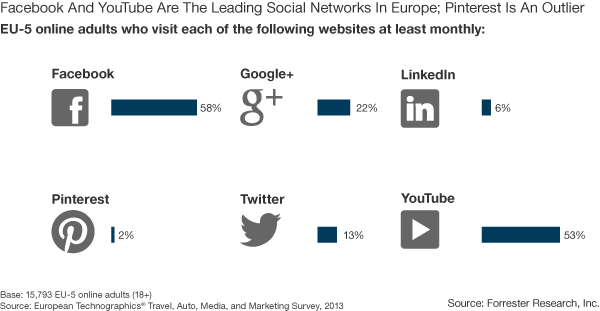The Data Digest: Why Pinning Isn’t Winning In Europe
In her recent report, my colleague Reineke Reitsma revealed that European consumers interact with a diverse suite of social networking sites, with Facebook and YouTube leading in terms of consumer engagement. Pinterest, however, is an outlier: European consumers demonstrate minimal interaction with Pinterest compared with both other social media sites and their US peers. According to Forrester’s Consumer Technographics® data, 18% of US online adults regularly visit the website but only 2% of European online adults across the UK, France, Germany, Italy, and Spain visit Pinterest once a month or more:

There are many reasons for Pinterest’s slow uptake among European consumers. For a global platform, Pinterest’s international strategy is still nascent — within the past 12 months, the brand has launched a French-specific version of the website and hired its first employees overseas with the intention of boosting localization tactics. Behind the scenes, the business is facing legal challenges in securing the Pinterest trademark in Europe; as a result, the company may need to change its web address and brand name when developing a presence outside the US. Corporate issues aside, European personalities simply might not support a culture of perpetual pinning. Data from Forrester’s ConsumerVoices market research online community suggests that Pinterest doesn’t motivate European consumers to share — nor to care. UK-based respondents believe that highlighting examples of their artistic accomplishments or practical skills on such a site is akin to unnecessary bragging.
The fact that Pinterest does gain significant traction in the US suggests that European marketers should keep an eye on the social media site rather than completely dismiss it, even if current Pinterest penetration in Europe is low. And, despite the uphill battle that Pinterest faces in engaging more socially savvy Europeans, engagement itself isn’t everything — the site’s potential to build value along with other social tools in the marketer’s toolbox is more important. According to a recent report by my colleague Nate Elliott, “Engagement is a tactic, not a metric. If you’re lucky, your customers will want to engage with your brand or company. But engagement is their goal, not yours. Your goal is to use that engagement to drive customers toward actions that create business value for your company.”
